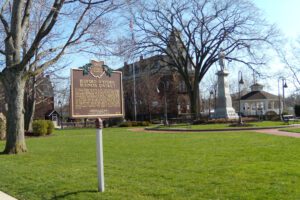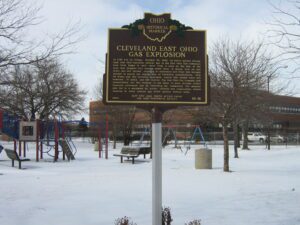, OH
Spring Grove received its charter by an act of the Ohio Legislature in January 1845. Motivated by crowded conditions of small cemeteries created by the cholera epidemics of the 1830s and 1840s, the Cincinnati Horticultural Society formed a cemetery association in 1844 to find a location for a rural cemetery. Under the guidance of Robert Buchanan, local attorney Salmon P. Chase drafted the charter that was granted, and Spring Grove, consisting of 166 acres designed with a natural setting embellished with shrubbery, flowers, trees, and walks, was dedicated on August 28, 1845. A leader in cemetery design and the landscape “lawn plan” concept, Spring Grove officially changed its name to Spring Grove Cemetery & Arboretum in 1987.
, OH
Dedicated in 1939 in a ceremony that turned the gardens over to the city, the Cleveland Cultural Gardens are a unique memorial to world peace and the celebration of cultural diversity. The Gardens date to 1916 when the Shakespeare garden was built, and are a celebration of cultural identity in the form of natural landscaping, formal architectural elements, and commemorative sculpture. Consisting of 23 individual gardens, the Gardens reflect the diversity of cultures that shaped Cleveland and the nation. The Gardens pay tribute to the many philosophers, scientists, composers, and other great thinkers who have made significant and lasting contributions to civilization. More importantly, the Gardens are symbolic of the fact that through preservation of many different traditions, beliefs, and practices, we may be better able to accept and respect one another – that we may achieve a true and lasting peace through mutual understanding.
, OH
In 1915, real estate developers William B. Welles and Badger C. Bowen formed the Ottawa Park Realty Company and in 1917 platted 323 residential lots near Toledo, Ohio. Named “Westmoreland” for the similarities with the rolling landscapes of Westmoreland County, Virginia, the neighborhood was placed on the National Register of Historic Places in 1986. Westmoreland features 215 original homes, most representing architectural Revival styles of the early 20th century including those of the Colonial, Jacobethan/Tudor, Italianate, French, and Spanish Revivals. This marker commemorates the centennial of the founding of Westmoreland. (Continued on other side)
, OH
The Ohio General Assembly established the Ohio Agricultural Experiment Station in 1882. From its inception until 1892, the Station occupied 17 acres on the Columbus campus of The Ohio State University before relocating to 470 acres in Wayne County. In 1965, the Station changed its name to the Ohio Agricultural Research and Development Center (OARDC) to more accurately reflect its mission and programs. In 1982, the Center formally merged with The Ohio State University. Today, the Center encompasses nearly 2,100 acres in Wayne County with 10 branches located across the state for a total of approximately 7,100 acres dedicated to agricultural research.
, OH
The town of Bedford was settled in 1837. Early residents, Hezekiah and Clarissa Dunham donated the land that serves as Bedford Public Square. The Dunhams built one of the area’s first homes in 1832, which stands at 729 Broadway with the letters H & D above the doorway. Early settlers were attracted to the area by the abundance of natural resources and a large waterfall for mill sites. Bedford also served as a stagecoach stop on the route from Cleveland to Pittsburgh. The road or Turnpike Road as it was called was originally part of the Mahoning Indian Trail. By 1895 the road was renamed Main Street (and later Broadway) when the Akron, Bedford, and Cleveland Railway Company (ABC) traversed the middle of the street carrying passengers. The interurban is called “America’s first high speed long distance electric interurban” with speeds in excess of 60 miles per hour. [continued on other side]
, OH
At 2:30 p.m. on Friday, October 20, 1944, an above ground storage tank that held liquefied natural gas in the East Ohio Gas Company’s tank farm began to emit vapor from a seam on the side of the tank that dropped into nearby sewer lines. It mixed with air and sewer gas and ignited, resulting in explosions and fires that brought damage to nearly one square mile of Cleveland neighborhoods. With 79 homes and two factories destroyed, nearly 700 people were left homeless, 131 killed, and 225 injured. The East Ohio Gas Company took responsibility for this tragedy to aid those in need through direct financial assistance and by rebuilding the community. The disaster also led to a movement by public utilities and communities across America to store natural gas below ground without tanks.
, OH
For more than 120 years, the natural amphitheater of Brookside Stadium has been a place of recreation for visitors to enjoy community events, festivals, and even a concert by John Philip Sousa. Engineered by William Stinchcomb, chief architect of the Cleveland Metroparks, Brookside Stadium officially opened as a premier space for sandlot baseball in May 1909. As amateur baseball found increased esteem, both locally and nationally, Brookside Stadium regularly became popular with thousands of spectators. On Sunday, October 10, 1915, it was host to the National Inter-City Amateur Championship, during which a crowd of an estimated 115,000 people witnessed the White Autos beat the Omaha Luxus 11 to 6. Although there was no formal ticketing system to verify the exact attendance, photographs taken that day strongly suggest that Brookside Stadium hosted the largest crowd in amateur baseball history.
, OH
In 1902, Albert Belmont Graham (1868-1960), a school teacher and superintendent, established the Boys and Girls Agricultural Experiment Club in Springfield, Ohio. Graham believed in learning by doing, a concept at the core of 4-H, which stands for Head, Heart, Hands, and Health. In 1905, Graham became the first Superintendent of Agricultural Extension at The Ohio State University and he brought the idea of 4-H with him. 4-H is in all 50 states and over 70 countries, and more than 7 million members enroll annually. One in six Ohioans have been members.









